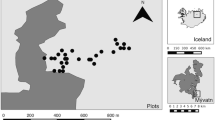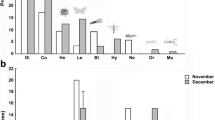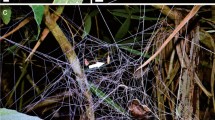Summary
Predation by orb-weaving spiders and crab spiders on the damselfly Calopteryx haemorrhoidalis was studied at a small stream in Southern France. One species of orb-weaving spider, Larinioides folium, caught 76% of the damselflies which fell prey to spiders. Displacement experiments on spiders on sections of bank and the positioning of webs in male territories show that the density and distribution of damselflies is not influenced by orbweb density or by the position of webs. Predation rates corresponded to orb-web density, but neither for sex nor for stage was there a relationship with damselfly density. Mean daily predation rates ranged between 0.9% for females and 4.1% for adult males. Predation risk to adult damselflies by orb-weaving spiders was male biased, whereas among tenerals there was no bias. Males were captured more frequently at territories near the water. Captures show a maximum at noon when territorial disputes of adult males were most frequent. After orbwebs were placed within territories predation rate of males was strongly increased. Predation risk to adult females in the direct vicinity of the stream was less than in the bank vegetation where they perch close to orbwebs. The risk of predation by crab spiders, which catch damselflies at their perching sites, was not sex-biased.
Similar content being viewed by others
References
Banks MJ, Thompson DJ (1987) Lifetime reproductive success of females of the damselfly Coenagrion puella. J Anim Ecol 56:815–832
Burk TE (1982) Evolutionary significance of predation on sexually signalling males. Flor Entomol 65:90–104
Cade W (1975) Acoustically orienting parasitoids: fly phonotaxis to cricket song. Science 90:1312–1313
Corbet PS (1962) A biology of dragonflies. Witherby, London
Craig CL (1986) Orb-web visibility: the influence of insect flight behaviour and visual physiology on the evolution of web designs within the Araneoidea. Anim Behav 34:54–68
Craig CL (1990) Effects of background pattern on insect perception of webs spun by orb-weaving spiders. Anim Behav 39:135–144
Davies NB, Houston AI (1984) Territory economics. In Krebs JR, Davies NB (eds) Behavioral ecology. Sinauer, Sunderland, Massachusetts, pp 148–169
Fincke OM (1988) Sources of variation in lifetime reproductive success in a nonterritorial damselfly (Odonata: Coenagrionidae). In: Clutton-Brock TH (ed) Reproductive success: studies of individual variation in contrasting breeding systems. University of Chicago Press, Chicago London, pp 24–43
Grabow K (1990) Beiträge zur Flächenbelastung mitteleuropäischer Odonaten. MSc Thesis, Univ Braunschweig
Gwynne DT (1987) Sex-biased predation and the risky mate-locating behaviour of male tick-tock cicadas (Homoptera: Cicadidae). Anim Behav 35:571–576
Gwynne DT, O'Neill KM (1980) Territoriality in digger wasps results in sex biased predation on males (Hymenoptera: Sphecidae, Philanthus). J Kansas Entomol Soc 53:220–224
Heymer A (1973) Verhaltensstudien an Prachtlibellen. Adv Ethol 11:1–100
Jones D (1990) Guide des araignées et des opilions d'Europe. Delachaux and Niestlé S. A., Neuchâtel and Paris
Kajak A (1965) An analysis of food relations between the spiders — Araneus cornutus Clerck and Araneus quadratus Clerck — and their prey in meadows. Ekol Pol A 13:717–764
Kerfoot C, Sih A (1987) Predation. Direct and indirect impacts on aquatic communities. University Press of New England, Hanover and London
Malt S, Sander FW, Schäller G (1990) Beitrag zur Nahrungsökologie ausgewählter Araneidae in Halbtrockenrasen unter besonderer Berücksichtigung von Argiope brunnichii (Scop.). Zool Jb Syst 117:237–260
marden JH, Waage JK (1990) Escalated damselfly territorial contests are energetic wars of attrition. Anim Behav 39:954–959
Michiels NK, Dhondt AA (1990) Costs and benefits associated with oviposition site selection in the dragonfly Sympetrum danae (Odonata: Libellulidae). Anim Behav 40:668–678
Miller P (1983) The duration of copulation correlates with other aspects of mating behaviour in Orthetrum chrysostigma (Burmeister) (Anisoptera: Libellulidae). Odonatologica 12:227–238
Morse DH, (1981) Prey capture by the crab spider Misumena vatia (Clerck) (Thomisidae) on three common native flowers. Am Midl Nat 105:358–367
Morse DH (1986) Predatory risk to insects foraging at flowers. Oikos 46:223–228
Nentwig W (1980) The selective prey of Linyphiid-like spiders and of their space webs. Oecologia 45:236–243
Nyffeler M, Benz G (1978) Die Beutespektren der Netzspinnen Argiope bruennichii (Scop.), Araneus quadratus Cl. und Agelena labyrinthica (cl.) in Ödlandwiesen bei Zürich. Rev Suisse Zool 85:747–757
Nyffeler M, Benz G (1989) Foraging ecology and predatory importance of a guild of orb-weaving spiders in a grassland habitat. J Appl Ent 107:166–184
Olive CW (1980) Foraging spezialisations in orb-weaving spiders. Ecology 61:1133–1144
O'Neill KM, Evans HE (1981) Predation on conspecific males by females of the beewolf Philanthus basilaris Cresson (Hymenoptera: Sphecidae). J Kansas Entomol Soc 54:553–556
Pasquet A (1984) Proies captureés et stratégies prédatrices chez deux espèces d'araignées orbitèles: Argiope bruennichi et Araneus marmoreus. Entomol Exp Appl 36:177–184
Rehfeldt GE (1990) Anti-predator strategies in oviposition site selection of Pyrrhosoma nymphula (Zygoptera: Odonata). Oecologia 84:233–237
Rehfeldt GE (1991) The upright male position during oviposition as an antipredator response in Coenagrion puella (Odonata: Coenagrionidae). Odonatologica 20:69–74
Resh VH, Rosenberg DM (1984) The ecology of aquatic insects. Praeger, New York Connecticut London
Robinson MH (1975) The evolution of predatory behavior in araneid spiders. In: Baerends G, Beer C, Manig A (eds) Function and evolution in behaviour. Clarendon, Oxford, pp 292–312
Rüppell G (1989) Kinematic analyses of symmetrical flight manoeuvres of Odonata. J Exp Biol 144:13–42
Shear WA (ed) (1986) Spiders. Webs, behavior, and evolution. Stanford Univ Press, Stanford
Stearns SC (1977) The evolution of life history traits. Annu Rev Ecol Syst 8:145–171
Thornhill R (1978) Some arthropod predators and parasites of adult scorpionflies (Mecoptera). Environ Ent 7:714–716
Trivers RL (1972) Parental investment and sexual selection. In: Campbell B (ed) Sexual selection and the descent of man. Aldine, Chicago, pp 139–179
Van Hook RI (1971) Energy and nutrient dynamics of spider and orthopteran populations in a grassland ecosystem. Ecol Monogr 41:1–26
Waage J (1972) Longevity and mobility of adult Calopteryx maculata (Beauvoir, 1805) (Zygoptera: Calopterygidae). Odonatologica 1:155–162
Waage J (1980) Adult sex ratios and female reproductive potential in Calopteryx (Zygoptera: Calopterygidae). Odonatologica 9:217–230
Waage J (1988) Confusion over residency and the escalation of damselfly disputes. Anim Behav 36:586–595
Wehner R (1981) Spatial vision in arthropods. In Autrum H (ed) Handbook of sensory physiology. Springer, New York, pp 287–616
Wolf LL, Waltz EC (1988) Oviposition site selection and spatial predictability of female White-faced dragonflies Leucorrhinia intacta (Odonata: Libellulidae). Ethology 78:306–320
Author information
Authors and Affiliations
Rights and permissions
About this article
Cite this article
Rehfeldt, G. Impact of predation by spiders on a territorial damselfly (Odonata: Calopterygidae). Oecologia 89, 550–556 (1992). https://doi.org/10.1007/BF00317162
Received:
Accepted:
Issue Date:
DOI: https://doi.org/10.1007/BF00317162




